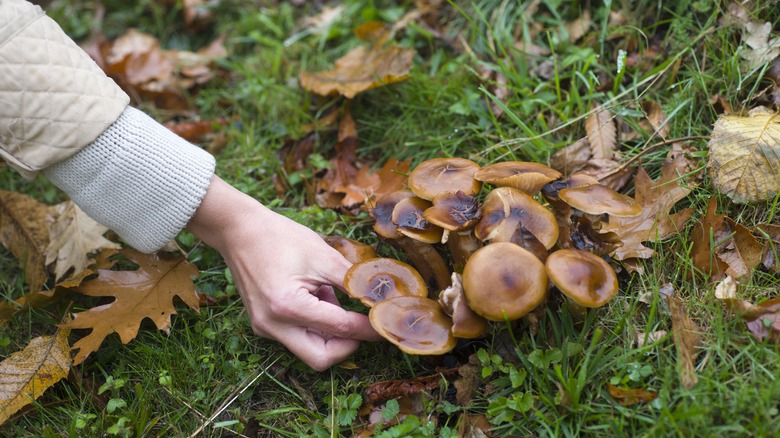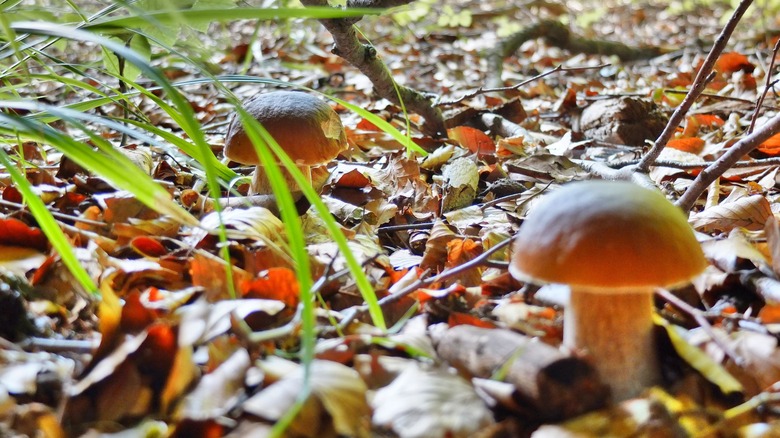Rid Your Lawn Of Mushrooms With A Handy Kitchen Staple
Ridding your lawn of mushrooms can be a challenging task for many homeowners. These pesky fungi seem to appear overnight and can quickly multiply. Although mushrooms are not harmful to the grass, their sudden arrival may raise concerns about underlying issues and aesthetics. Fortunately, there is a simple and readily available solution to help address this issue: dish soap.
Dish soap is known for its ability to cut through grease and grime, but this handy kitchen staple also presents an alternative method for combating unwanted fungi in lawns. Homeowners can create a mixture using dish soap and water to kill and prevent the regrowth of mushrooms. However, it's important to understand the limitations and potential risks associated with this method and to consider other factors that can contribute to shroom growth in lawns. Before delving into the dirty (or clean) work, let's explore the root causes of this spore-bearing organism's presence in the first place.
How to fend off shrooms with dish soap
Fending off growing mushrooms can be daunting, as their spores spread and reproduce easily. While addressing the underlying causes is essential, you can take quick action using dish soap. Create a mixture by combining 1 to 2 tablespoons of dish soap with 3 gallons of water. Once dissolved, pour the soapy solution over and around the fungi. It is recommended to aerate the soil around the mushrooms before applying the liquid to ensure proper drainage. Within 24 hours, the dish soap mixture will start working to kill off the unwanted fungi.
For homeowners battling a large colony of shrooms, it may be necessary to repeat this process to attain the desired outcome. Conversely, those dealing with only a few isolated ones can use a smaller quantity of the solution and even transfer it to a spray bottle for targeted application. Once the mushrooms have died, removing any visible remnants from the soil is crucial. Remember to wear gloves and place the debris in a bag to prevent the spread of spores. In some instances, removing portions of the soil may be necessary to eradicate the mushrooms in full.
Balancing mushroom growth
Even though mushrooms can be a nuisance, it is best to exercise caution when using soap to eliminate them. While dish soap counteracts the hyphae, the elongated filamentous branches found in fungi, using high soap concentrations can affect the soil's pH balance and impact grass growth. To ensure that this method does not adversely affect your lawn, measuring the pH of your soil is recommended. You can do this without needing a kit by conducting DIY soil tests. In addition, before making widespread soap applications across your lawn, test the mixture on a small area first to avoid potential damage.
It's also important to know why mushrooms are emerging, taking into consideration of the soil and what that really implies for the environment in which fungi thrive. A common reason fungi proliferate in lawns is due to excessive moisture. Whether it results from overwatering, poor drainage, or heavy rainfall, consistently damp conditions create the ideal setting. If you notice standing water in your lawn, this could result from compacted soil. Water struggles to infiltrate and evaporate in tightly packed dirt, providing the ideal conditions for mushrooms to flourish. It's advised to aerate your yard to alleviate compaction. This process involves perforating the soil, allowing air, water, and nutrients to reach grass roots. Nature's nuggets also prosper on decomposed organic matter, including fallen leaves, dead tree roots, or other decaying foliage. If your yard has a buildup of such materials, it creates an inviting breeding habitat.

